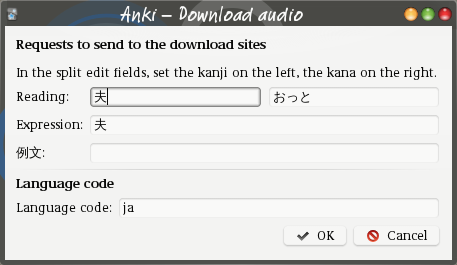Use the standard add-ons when learning Japanese or Chinese.
Japanese
When learning Japanese, using this add-on is much easier when the Japanese Support add-on has been installed first.
This add-on assumes that there is a field called Reading
and
that this reading field contains both the Japanese word itself (kanji
and kana written in line) and the reading of the kanji (furigana).
The furigana should be in square brackets
([
,
]
)
after the kanji. A
space is
used as the break between leading characters and the kanji for which
there is a reading. For example, for the expressionこの間
, the reading field should contain
. Note the space between この 間
[あいだ]の
and 間
and the square brackets around the あいだ
.
Most of the time these details are not important. This square-bracket style is exactly what is produced by the Japanese Support add-on. When creating cards you typically just type the expression into its field, and when you go to the meaning field to type the translation, the reading field is filled automatically in the right format.
Using two fields
Some people store just the kana in the Reading
field, for example by
using %r instead of %e[%r] to fill the field in the settings of
the Yomichan add-on.
With this set-up, downloads from JapanesePod will not work without
change. By default the add-on expects to find the kanji in the reading
field.

Set split_kanji_kana to True in the
get_fields.py
file when you use this set-up. With this the JapanesePod downloader
takes the kanji and kana from separate fields. Check with the
Manual audio
menu item, there should be a line with two edit
fields and the kanji in the left and the kana in the right field.